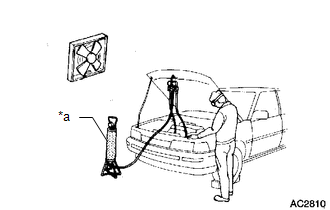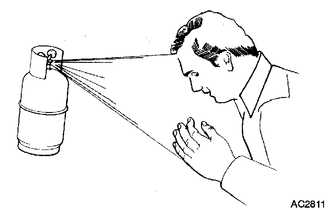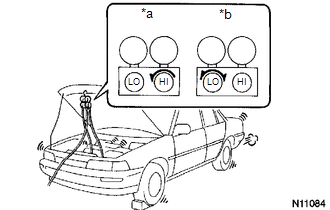Lexus NX: Precaution
PRECAUTION
PRECAUTION FOR DISCONNECTING CABLE FROM NEGATIVE AUXILIARY BATTERY TERMINAL
NOTICE:
-
After the power switch is turned off, there may be a waiting time before disconnecting the negative (-) auxiliary battery terminal.
Click here
.gif)
-
When disconnecting and reconnecting the auxiliary battery terminal
Click here
.gif)
HINT:
When disconnecting and reconnecting the auxiliary battery, there is an automatic learning function that completes learning when the respective system is used.
Click here
.gif)
DO NOT HANDLE REFRIGERANT IN AN ENCLOSED AREA OR NEAR AN OPEN FLAME

| *a | Charging Cylinder |
ALWAYS WEAR EYE PROTECTION
BE CAREFUL NOT TO GET LIQUID REFRIGERANT IN YOUR EYES OR ON YOUR SKIN

If liquid refrigerant gets in your eyes or on your skin:
(a) Wash the area with lots of cold water.
CAUTION:
Do not rub your eyes or skin.
(b) Apply clean petroleum jelly to the skin.
(c) Go immediately to a hospital or see a physician for professional treatment.
NEVER HEAT CONTAINER OR EXPOSE THE CONTAINER TO AN OPEN FLAME
BE CAREFUL NOT TO DROP CONTAINER OR APPLY PHYSICAL SHOCKS TO IT
DO NOT OPERATE COMPRESSOR WITHOUT ENOUGH REFRIGERANT IN REFRIGERANT SYSTEM
If there is not enough refrigerant in the air conditioning system, oil lubrication will be insufficient and the compressor may be damaged.
Necessary care should be taken to avoid this.
DO NOT OPEN HIGH PRESSURE MANIFOLD VALVE WHILE COMPRESSOR IS OPERATING

| *a | Wrong |
| *b | Okay |
(a) Open and close only the low pressure valve.
If the high pressure valve is opened, refrigerant flows in the reverse direction causing the charging cylinder to rupture.
BE CAREFUL NOT TO OVERCHARGE SYSTEM WITH REFRIGERANT
If the system is overcharged with refrigerant, it causes problems such as insufficient cooling, poor fuel economy, engine overheating, etc.
DO NOT OPERATE ENGINE AND COMPRESSOR WITH NO REFRIGERANT
CAUTION:
Doing so may damage inside the compressor because the compressor parts always move regardless of whether the air conditioning system is turned on or off.
SUPPLEMENTAL RESTRAINT SYSTEM (SRS)
(a) This vehicle is equipped with a Supplemental Restraint System (SRS) such as the driver, front passenger, side, and curtain shield airbags. Failure to carry out service operations in the correct sequence could cause the SRS to unexpectedly deploy during servicing, possibly leading to a serious accident. Before servicing (including removal/installation, inspection or replacement of parts), be sure to read the precautionary notices.
Click here .gif)
GENERAL PRECAUTION
(a) While using the auxiliary battery during inspection, do not bring the positive (+) and negative (-) tester probes too close to each other as a short circuit may occur.

